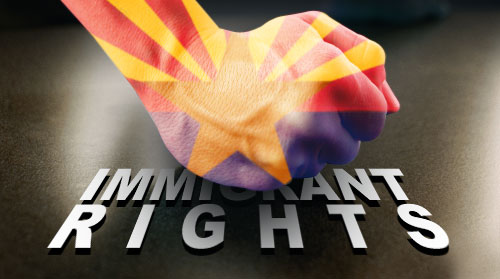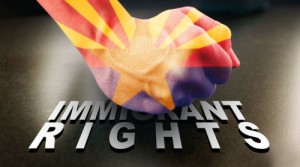Phoenix City Council Considering Local ID for Undocumented Immigrants

 By Valeria Fernández, New America Media
By Valeria Fernández, New America Media
“I’m talking to our legal counsel to see what we can do,” said Michael Nowakowski, who represents Phoenix District 7, which has a heavily Latino population. “We have to make sure people feel safe when they call the police.”
 Although, both supporters and opponents of SB 1070 have raised concerns about the possible use of local ID cards, this and other proposals show that anti-immigrant measures in Arizona and elsewhere continue to face challenges on different fronts.
Although, both supporters and opponents of SB 1070 have raised concerns about the possible use of local ID cards, this and other proposals show that anti-immigrant measures in Arizona and elsewhere continue to face challenges on different fronts.
Federal Actions, Sheriff Arpaio and Phoenix Police
Following recent actions in federal courts, Phoenix Police started enforcing section 2(b) of the law. It requires them to contact immigration authorities if they suspect a person they detained is in the United States without authorization.
In June, the U.S. Supreme Court nullified much of SB 1070, but left intact the provision requiring Arizona law enforcement officials to check the immigration status of anyone a police officer believes might be in this country unlawfully. The court, though, left open the possibility of further challenges to the law, if its opponents could document a pattern of racial discrimination.
Then in early September, a U.S. District Court judge lifted a previous injunction that halted the law’s implementation.
Last Tuesday, after only two week of enforcement, advocates for immigrants presented the City Council committee on which Nowakowski serves with numerous complaints alleging ethnic profiling.
“They’re doing the same thing that Sheriff [Joe] Arpaio does, only they are not saying it,” said Salvador Reza, a pro-immigrant activist from the Neighborhood Defense Committee that has been collecting these accusations.
Arpaio, the Sheriff of Maricopa County, is famous for conducting sweeps on immigrant neighborhoods. Arpaio and his agency are under investigation by the U.S. Department of Justice and are facing a federal class-action lawsuit for racial profiling.
Meanwhile, Phoenix Police Chief Daniel Garcia pledged that he will adopt a zero tolerance policy on racial profiling for his officers.
Alejandra Garcia, the sister of an undocumented immigrant who was pulled over by the police, testified at the City Council meeting on Tuesday that the officers had no valid reason for the traffic stop.
According to Police Department spokesperson Tommy Thompson, Phoenix officers pulled over her brother, Arturo Garcia, for an illegal turn. He had no driver’s license, didn’t much speak English and showed the police a Mexican passport.
“Based on the circumstances we called ICE [federal Immigration and Customs Enforcement],” said Thompson. The officer ended up driving Garcia and his two passengers to the office of ICE.
ID Might Preclude Calling ICE
Nowakowski said that law-enforcement officers need to be able to identify the people they come in contact with, even for a traffic violation. The information on a city-issued ID might preclude officers from having to contact ICE.
“How do they know who you are to give you a citation,” Nowakowski asked?
Undocumented immigrants have few options when it comes to identifying themselves with the police, if they are stopped for a traffic or other offense, he said.
The state doesn’t allow undocumented people to obtain a driver’s license or state issued ID. Also, officers are known to dismiss the legitimacy of some foreign documents or to use them to question whether the person is in the United States legally.
Currently, the Phoenix Police Department doesn’t recognize the Mexican Matricula card, an ID issued by the Mexican government. This is because it doesn’t have visible biometric information, such as height and weight of a person, said Nowakowski.
That information is encrypted in the ID and can be read through a special scanner, but Thompson of the Phoenix Police Department said officers shouldn’t have to rely on having a scanner to get this information.
While it sounds like a practical solution on its face, Reza worried that a city ID would raise even more suspicion among police that a person is in the U.S. illegally. The uncertainty might compel them to call ICE just to make sure they were following the law.
“Getting an ID for residents of the city won’t give them protection or allow them do obtain a driver’s license from the state,” said Reza. “Police officers will still enforce SB 1070.”
Reza believes that a better alternative would be to get the City Council to approve a resolution to make Phoenix an “Immigrant Welcoming City” following the footsteps of Tucson, which adopted this policy last August.
Councilmember’s agreed that like federal authorizes, Tucson Police should align focus on people committing serious crimes or who were previously deported.
“What’s most important is that the [Phoenix] City Council approve a resolution that would prevent officers from engaging in racial profiling,” said Reza.
Devil in the Details
Phoenix is not the first city that could consider the possibility of creating its own ID to help undocumented immigrants identify themselves. Dayton, Ohio contemplated it last year and had to drop the idea when they realize it was impractical and it could backfire.
Dayton, population 150,000, approved a resolution to be an “Immigrant Welcoming City” last October.
Tom Wahlbar, a former executive director of the Dayton’s Human Relations Council, helped draft the resolution, which grassroots organizations presented to the City Council as a community initiative.
But Wahlbar said the city found adding the local ID program would not be wasn’t cost effective for a jurisdiction of Dayton’s modest size. Another concern, he noted, was that only undocumented immigrants would apply for the IDs, creating a “list that becomes a public document that can be accessible to anybody including ICE.”
A major difference between Dayton and communities in Phoenix, Wahlbar emphasized, is that the policy for Dayton police is not to inquire about a person’s immigration status, even if a person does not have identification.
This article was first posted in New America Media.
[Photo by New America Media]
